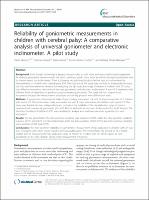Por favor, use este identificador para citar o enlazar este ítem:
https://repositorio.usj.es/handle/123456789/265
Registro completo de metadatos
| Campo DC | Valor | Lengua/Idioma |
|---|---|---|
| dc.contributor.author | Herrero Gállego, Pablo | - |
| dc.contributor.author | Carrera, Patricia | - |
| dc.contributor.author | García, Elena | - |
| dc.contributor.author | Gámez-Trullén, Eva M. | - |
| dc.contributor.author | Oliván-Blázquez, Bárbara | - |
| dc.date.accessioned | 2019-12-12T12:05:29Z | - |
| dc.date.available | 2019-12-12T12:05:29Z | - |
| dc.date.issued | 2011-07-11 | - |
| dc.identifier.citation | Herrero, P., Carrera, P., García, E., Gómez-Trullén, E. M., & Oliván-Blázquez, B. (2011). Reliability of goniometric measurements in children with cerebral palsy: a comparative analysis of universal goniometer and electronic inclinometer. A pilot study. BMC musculoskeletal disorders, 12, 155. doi:10.1186/1471-2474-12-155 | es_ES |
| dc.identifier.issn | 1471-2474 | es_ES |
| dc.identifier.uri | https://repositorio.usj.es/handle/123456789/265 | - |
| dc.description.abstract | Background Even though technological progress has provided us with more and more sophisticated equipment for making goniometric measurements, the most commonly used clinical tools are still the universal goniometer and, to a lesser extent, the inclinometer. There is, however, no published study so far that uses an inclinometer for measurements in children with cerebral palsy (CP). The objective of this study was two-fold: to independently assess the intra and inter-examiner reliability for measuring the hip abduction range of motion in children with CP using two different instruments, the universal two-axis goniometer and electronic inclinometer. A pool of 5 examiners with different levels of experience as paediatric physiotherapists participated. The study did not compare both instruments because the measurement procedure and the hip position were different for each. Methods A prospective, observational study of goniometery was carried out with 14 lower extremities of 7 children with spastic CP. The inclinometer study was carried out with 8 lower extremities of 4 children with spastic CP. This study was divided into two independent parts: a study of the reliability of the hip abduction range of motion measured with a universal goniometer (hip at 0° flexion) and with an electronic inclinometer (hip at 90° flexion). The Intraclass Correlation Coefficient (ICC) was calculated to analyse intra and inter-examiner agreement for each instrument. Results For the goniometer, the intra-examiner reliability was excellent (>0.80), while the inter-examiner reliability was low (0.375 and 0.475). For the inclinometer, both the intra-examiner (0.850-0.975) and inter-examiner reliability were excellent (0.965 and 0.979). Conclusions The inter-examiner reliability for goniometric measurement of hip abduction in children with CP was low, in keeping with other results found in previous publications. The inclinometer has proved to be a highly reliable tool for measuring the hip abduction range of motion in children with CP, which opens up new possibilities in this field, despite having some measurement limitations. | es_ES |
| dc.format.extent | 8 p. | es_ES |
| dc.format.mimetype | application/pdf | es_ES |
| dc.language.iso | eng | es_ES |
| dc.publisher | Springer Nature | es_ES |
| dc.rights | Atribución 4.0 Internacional | * |
| dc.rights.uri | http://creativecommons.org/licenses/by/4.0/ | * |
| dc.subject | Parálisis cerebral | es_ES |
| dc.title | Reliability of goniometric measurements in children with cerebral palsy: A comparative analysis of universal goniometer and electronic inclinometer. A pilot study | es_ES |
| dc.type | info:eu-repo/semantics/article | es_ES |
| dc.subject.unesco | Niño | es_ES |
| dc.identifier.doi | 10.1186/1471-2474-12-155 | es_ES |
| dc.rights.accessrights | info:eu-repo/semantics/openAccess | es_ES |
| Aparece en las colecciones: | Artículos de revistas | |
Ficheros en este ítem:
| Fichero | Descripción | Tamaño | Formato | |
|---|---|---|---|---|
| Reliability of goniometric measurements inchildren with cerebral palsy.pdf | 707,54 kB | Adobe PDF |  Visualizar/Abrir |
Este ítem está sujeto a una licencia Creative Commons Licencia Creative Commons

